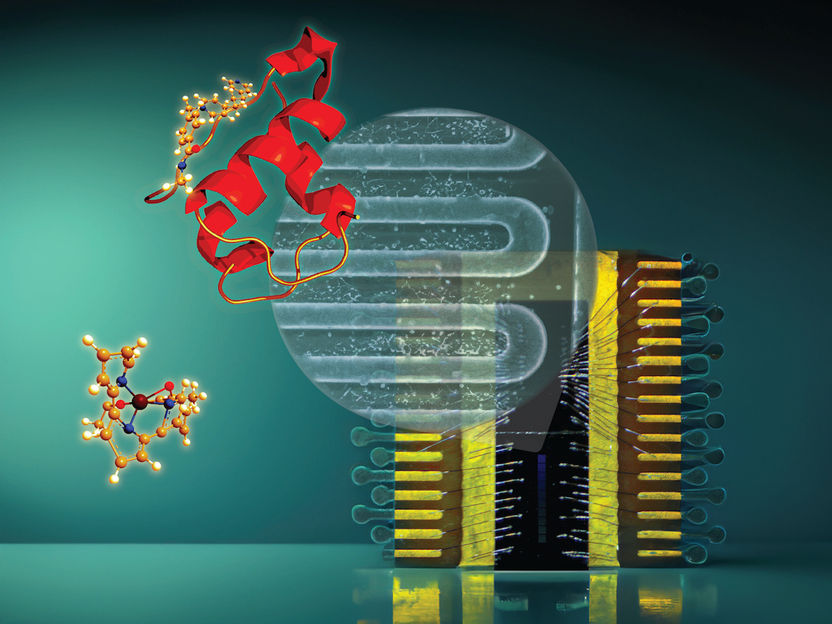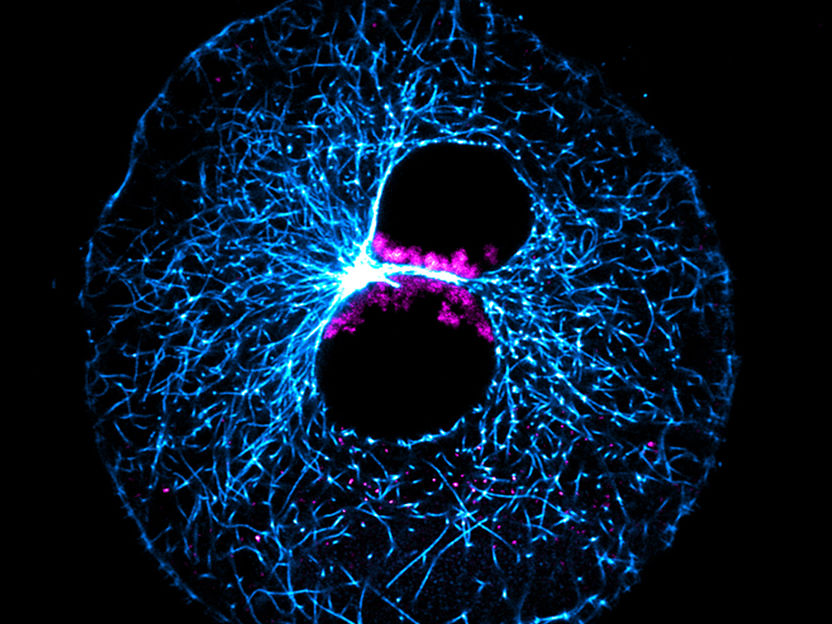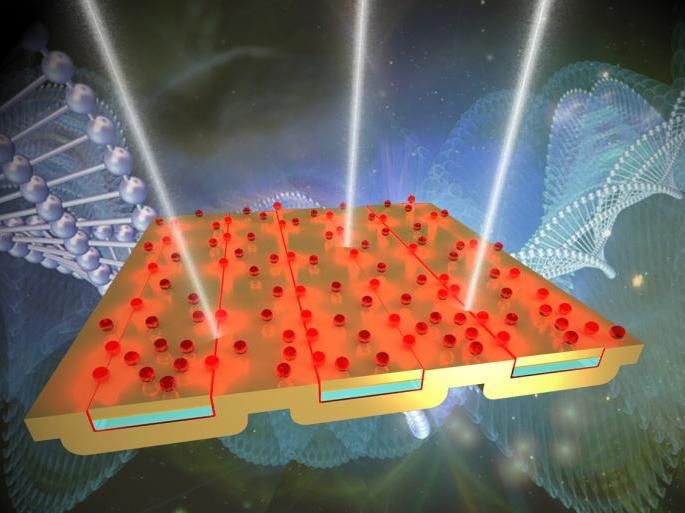Superconducting Nanowires Detect Single Protein Ions
Detection efficiency 1,000 times higher than conventional ion detectors due to high sensitivity
An international research team led by quantum physicist Markus Arndt (University of Vienna) has achieved a breakthrough in the detection of protein ions: Due to their high energy sensitivity, superconducting nanowire detectors achieve almost 100% quantum efficiency and exceed the detection efficiency of conventional ion detectors at low energies by a factor of up to a 1,000. In contrast to conventional detectors, they can also distinguish macromolecules by their impact energy. This allows for more sensitive detection of proteins and it provides additional information in mass spectrometry. The results of this study were recently published in the journal Science Advances.

Counting single proteins with a superconducting nanowire. The background and nanowire are altered in Photoshop with the Generative Fill AI. (Human Insulin PDB:3I40).
Copyright: CC BY-ND 4.0 Quantum Nanophysics University of Vienna
The detection, identification, and analysis of macromolecules is interesting in many areas of life sciences, including protein research, diagnostics, and analytics. Mass spectrometry is often used as a detection system – a method that typically separates charged particles (ions) according to their mass-to-charge-ratio and measures the intensity of the signals generated by a detector. This provides information about the relative abundance of the different types of ions and therefore the composition of the sample. However, conventional detectors have only been able to achieve high detection efficiency and spatial resolution for particles with high impact energy – a limitation that has now been overcome by an international team of researchers using superconducting nanowire detectors.
Joined forces for low energy particles
In the current study, a European consortium coordinated by the University of Vienna, with partners in Delft (Single Quantum), Lausanne (EPFL), Almere (MSVision) and Basel (University), demonstrates for the first time the use of superconducting nanowires as excellent detectors for protein beams in so-called quadrupole mass spectrometry. Ions from the sample to be analyzed are fed into a quadrupole mass spectrometer where they are filtered. "If we now use superconducting nanowires instead of conventional detectors, we can even identify particles that hit the detector with low kinetic energy," explains project leader Markus Arndt from the Quantum Nanophysics Group at the Faculty of Physics at the University of Vienna. This is made possible by a special material property (superconductivity) of the nanowire detectors.
Getting there with superconductivity
The key to this detection method is that nanowires enter a superconducting state at very low temperatures, in which they lose their electrical resistance and allow lossless current flow. Excitation of the superconducting nanowires by incoming ions causes a return to the normal conducting state (quantum transition). The change in the electrical properties of the nanowires during this transition is interpreted as a detection signal. "With the nanowire detectors we use," says first author Marcel Strauß, "we exploit the quantum transition from the superconducting to the normal conducting state and can thus outperform conventional ion detectors by up to three orders of magnitude." Indeed, nanowire detectors have a remarkable quantum yield at exceptionally low impact energies – and redefine the possibilities of conventional detectors: "In addition, a mass spectrometer adapted with such a quantum sensor can not only distinguish molecules according to their mass to charge state, but also classify them according to their kinetic energy. This improves the detection and offers the possibility for have better spatial resolution," says Marcel Strauß. Nanowire detectors can find new applications in mass spectrometry, molecular spectroscopy, molecular deflectometry, or quantum interferometry of molecules, where high efficiency and good resolution are required, especially at low impact energy.
Original publication
Marcel Strauß, Armin Shayeghi, Martin F. X. Mauser, Philipp Geyer, Tim Kostersitz, Julia Salapa, Oleksandr Dobrovolskiy, Steven Daly, Jan Commandeur, Yong Hua, Valentin Köhler, Marcel Mayor, Jad Benserhir, Claudio Bruschini, Edoardo Charbon, Mario Castaneda, Monique Gevers, Ronan Gourgues, Nima Kalhor, Andreas Fognini, Markus Arndt; "Highly sensitive single-molecule detection of macromolecule ion beams"; Science Advances, Volume 9
Most read news
Original publication
Marcel Strauß, Armin Shayeghi, Martin F. X. Mauser, Philipp Geyer, Tim Kostersitz, Julia Salapa, Oleksandr Dobrovolskiy, Steven Daly, Jan Commandeur, Yong Hua, Valentin Köhler, Marcel Mayor, Jad Benserhir, Claudio Bruschini, Edoardo Charbon, Mario Castaneda, Monique Gevers, Ronan Gourgues, Nima Kalhor, Andreas Fognini, Markus Arndt; "Highly sensitive single-molecule detection of macromolecule ion beams"; Science Advances, Volume 9
Topics
Organizations
Other news from the department science

Get the life science industry in your inbox
By submitting this form you agree that LUMITOS AG will send you the newsletter(s) selected above by email. Your data will not be passed on to third parties. Your data will be stored and processed in accordance with our data protection regulations. LUMITOS may contact you by email for the purpose of advertising or market and opinion surveys. You can revoke your consent at any time without giving reasons to LUMITOS AG, Ernst-Augustin-Str. 2, 12489 Berlin, Germany or by e-mail at revoke@lumitos.com with effect for the future. In addition, each email contains a link to unsubscribe from the corresponding newsletter.
Most read news
More news from our other portals
See the theme worlds for related content
Topic world Protein analytics
Protein analytics provides a deep insight into these complex macromolecules, their structure, function and interactions. It is essential for discovering and developing biopharmaceuticals, understanding disease mechanisms, and identifying therapeutic targets. Techniques such as mass spectrometry, Western blot and immunoassays allow researchers to characterize proteins at the molecular level, determine their concentration and identify possible modifications.

Topic world Protein analytics
Protein analytics provides a deep insight into these complex macromolecules, their structure, function and interactions. It is essential for discovering and developing biopharmaceuticals, understanding disease mechanisms, and identifying therapeutic targets. Techniques such as mass spectrometry, Western blot and immunoassays allow researchers to characterize proteins at the molecular level, determine their concentration and identify possible modifications.
Topic World Spectroscopy
Investigation with spectroscopy gives us unique insights into the composition and structure of materials. From UV-Vis spectroscopy to infrared and Raman spectroscopy to fluorescence and atomic absorption spectroscopy, spectroscopy offers us a wide range of analytical techniques to precisely characterize substances. Immerse yourself in the fascinating world of spectroscopy!

Topic World Spectroscopy
Investigation with spectroscopy gives us unique insights into the composition and structure of materials. From UV-Vis spectroscopy to infrared and Raman spectroscopy to fluorescence and atomic absorption spectroscopy, spectroscopy offers us a wide range of analytical techniques to precisely characterize substances. Immerse yourself in the fascinating world of spectroscopy!
Topic World Mass Spectrometry
Mass spectrometry enables us to detect and identify molecules and reveal their structure. Whether in chemistry, biochemistry or forensics - mass spectrometry opens up unexpected insights into the composition of our world. Immerse yourself in the fascinating world of mass spectrometry!

Topic World Mass Spectrometry
Mass spectrometry enables us to detect and identify molecules and reveal their structure. Whether in chemistry, biochemistry or forensics - mass spectrometry opens up unexpected insights into the composition of our world. Immerse yourself in the fascinating world of mass spectrometry!
Last viewed contents
Category:Flavin_enzymes
Distraction_osteogenesis
California_Proposition_215_(1996)
Federica_Sallusto

Immune system of plants: It works differently than expected

New tool reveals function of enigmatic gene sequences - Study may eventually contribute to the development of new, targeted drugs
Methanol

How the first biomolecules could have been formed - International team shows that the first biologically relevant compounds could have originated on Earth's surface

Errors at the start of life - The process of combining maternal and paternal genetic information is surprisingly error-prone
Royal_College_of_Physicians





















































